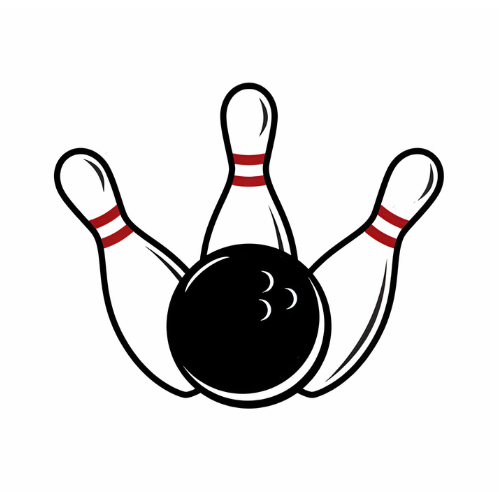Bowling ball numbers refer to the weight of the ball, typically ranging from 6 to 16 pounds. They also indicate information on the ideal hole sizes for gripping the ball.
Understanding bowling ball numbers is crucial for both novice and seasoned bowlers seeking the perfect match for their game. This knowledge ensures comfort, control, and consistency in every roll. Selecting the right bowling ball weight is essential, as a ball too heavy can lead to injury, while one too light might hinder performance.
Each bowler needs to consider their own strength and skill level when making this choice. Identifying the correct grip size also aids in preventing strain and improving accuracy. With these factors in mind, bowlers can enhance their overall experience and up their chances of striking success on the lanes.
:max_bytes(150000):strip_icc()/BowlingScore-58b9e57e3df78c353c580d98.jpg)
Credit: www.liveabout.com
Decoding The Digits: Bowling Ball Markings
Understanding the weight of a bowling ball is critical for players. A ball’s weight impacts the swing and release. Heavier balls can knock down more pins. Lighter balls are easier for some to control. Bowlers choose weights that match their own strength and style.
The Radius of Gyration (RG) describes how a ball spins. It’s a measure of a ball’s balance. Low RG balls spin more easily than high RG balls. This can affect how the ball moves down the lane. Knowing your ball’s RG can help you make better shots.
Perfecting Your Pick: Understanding Ball Numbers
Knowing your bowling ball’s numbers is vital for game improvement. Weight, RG (Radius of Gyration), and differential are numbers to master. These numbers influence how a ball rolls. A higher RG ball delays its hook on the lane. Contrastingly, a lower RG sparks an earlier roll. Differential reveals the ball’s potential hook. More differential means more flare and wider reaction.
Coverstock codes are also crucial. They tell us the ball’s surface type. Plastic, reactive resin, urethane, and particle are common types. Each type interacts differently with the lane. Choose plastic for straight shots. Reactive resin is best for strong backend reactions. Urethane offers control and smoother hooks. Particle balls provide the greatest traction on oily surfaces. Select wisely based on your playing style and lane conditions.
Strike Strategy: Number Impacts On Game Performance
Understanding bowling ball numbers can vastly improve your game. Specific numbers affect the strategy for strikes and spares. For strikes, rely on balls with higher numbers, reflecting greater hook potential. Heavier balls usually carry numbers from 14 to 16. These are ideal for knocking down all ten pins.
For spares, you need precision. Lower numbered balls, indicating less hook, help with accuracy. Bowlers often choose numbers between 10 and 12. These balls are easier to control. Picking the right ball for spare situations is crucial. Players should have both low and high number balls in their arsenal.
Successful bowlers understand the synergy between ball numbers and lane conditions. A combination of the two determines which ball to use. Typical high-scoring combos involve a 16 for strikes and a 12 for spares.
Expert Insights: Pro Bowlers’ Number Choices
Pro bowlers often select ball numbers linked to their average scores. High numbers, like 14, 15, or 16, are common among experts. These balls offer a balance of control and power. Personal preference plays a significant role. Experienced players look for a ball that complements their throwing style.
Alley conditions can affect ball choice. Different lane materials require specific ball types. Wooden lanes often warrant heavier balls for more impact. On synthetic lanes, lighter numbers might provide better control. Pro players consider these factors before making their selection.
Gear Up For The Lanes: Selecting Your Bowling Ball
Understanding bowling ball numbers is key for scoring high. The weight label on balls often sparks discussion. A common belief is heavier balls knock down more pins. Not always true! Skill and comfort dictate performance more than just weight.
Choose a ball that feels right in your hand. Balance between control and power is crucial. Don’t fall for the myth that bigger numbers mean better scores. Each player has a unique, ideal ball number, personal to their play style.
Regular maintenance ensures these numbers stay readable. This is not just about appearance. Visible numbers help to quickly identify your ball. It means smooth play without delays. For top performance, keep your ball clean and the numbers clearly visible.
FAQ
What Do The Numbers Mean On Bowling Ball?
The numbers on a bowling ball indicate its weight in pounds, typically ranging from 6 to 16 lbs for standard balls used by most players.
How Do I Choose A Bowling Ball Number?
Choose a bowling ball by considering your weight and skill level. Aim for a ball that’s roughly 10 percent of your body weight, but don’t exceed 16 pounds. Test different grip sizes for comfort and control to ensure optimal performance on the lanes.
What Do The 3 Numbers In A Bowling Ball Layout Mean?
The three numbers in a bowling ball layout specify the distances to the pin, mass bias, and the pin buffer, defining ball rotation, hook potential, and reaction.
What Does A High Rg Bowling Ball Mean?
A high RG (Radius of Gyration) bowling ball delays hooking on the lane, enhancing control and length before it makes its turn.
Conclusion
Understanding the numbers on bowling balls is crucial for improving your game. They guide weight, balance, and hook potential. Armed with this knowledge, you’re set to make informed choices. Remember, the right ball can significantly boost your performance. So, choose wisely and let those pins fall!
